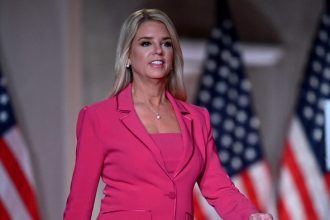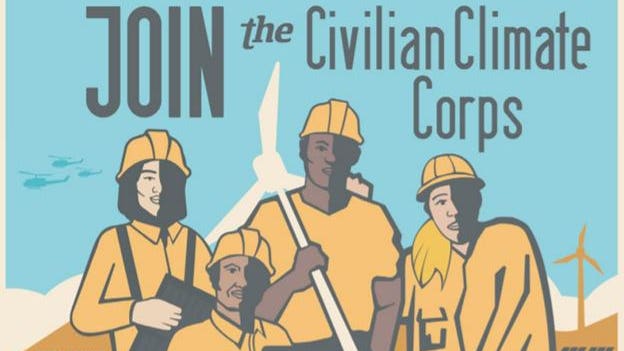Ninety years ago, President Roosevelt’s Civilian Conservation Corps put millions of Americans to work building a stronger country, confronting the biggest crisis of its time – the Great Depression.
This week President Biden launched the American Climate Corps, to put tens of thousands of Americans to work fighting the biggest crisis of our time – climate change.
The American Climate Corps has been part of the Biden administration’s dual push to create jobs and confront climate change since the first week of his presidency. It was formally proposed as the Civilian Climate Corps in the Build Back Better Act, but was stripped from the Inflation Reduction Act (IRA) during legislative negotiations.
American Climate Corps, more than just an infrastructure program
The American Climate Corps could become the connective tissue enabling the IRA to create a just transition and build resilient communities.
“President Biden’s administration has taken a big step toward delivering good jobs for young people in the booming clean energy economy,” said Trevor Dolan, Industry & Workforce Policy Lead at Evergreen Action and author of a 2021 report recommending Civilian Climate Corps program design. “Young people growing up amid the climate crisis have an acute understanding of what we’re up against, and now they have an opportunity to fight it head-on.”
The program was inspired by President Franklin Roosevelt’s Civilian Conservation Corps, established in the depths of the Great Depression, which operated from 1933 to 1942. Roughly 3 million workers planted billions of trees, built hundreds of thousands of dams and roads, and expanded our national parks.
Perhaps more importantly, the Civilian Conservation Corps boosted lifetime earnings and the long-term health of participants, remaining extraordinarily popular with the population. Workers didn’t focus on Democratic or Republican projects, they worked on infrastructure that benefited communities and the country for decades to come. Boosting earnings and building infrastructure are just as important today as they were in the 1930s.
The idea is incredibly popular, with polling showing 77% of likely voters support creating a Civilian Climate Corps, including 65% of Republicans and 87% of Democrats. The approach also creates compounding economic benefits – analysis shows the federal government receives $3.50 for every dollar it spends on AmeriCorps, rising to $17 when benefits to communities and corps members are included.
An integrated approach to multiple federal initiatives
The American Climate Corps is the product of numerous federal legislative initiatives and integrates multiple bills introduced in Congress in recent years.
The Civilian Climate Corps for Jobs and Justice Act from Sen. Ed Markey and Rep. Ocasio-Cortez set a high bar for labor standards including a $15 per hour minimum wage requirement as well as dedicating funding and hiring to frontline or environmental justice communities, as part of $132.5 billion in federal funding.
The Youth Corps Act outlined training and career development standards, the 21st Century Civilian Conservation Corps Act highlighted how to jointly fund corpsmember deployment and Corps projects, and the RENEW Conservation Corps Act required a $15 per hour living wage along with robust educational benefits.
And because national and statewide corps are already in operation with thousands of young people serving around the country, the American Climate Corps won’t have to start from scratch.
Administration officials say the program will be implemented among six federal agencies including the U.S. Department of Energy and Department of Labor through a formal agreement to share existing authority and resources. Other federal entities like AmeriCorps would implement the program – for example the first formal American Climate Corps project is “Forest Corps,” a five-year $15 million initiative between AmeriCorps and the U.S. Forest Service.
Putting young Americans to work strengthening our communities
Potential corps projects are almost endless, considering the country’s under-invested infrastructure needs.
Corps members could tackle some of the National Park Service’s $12 billion backlog of needed repairs. They could help prevent the unprecedented wildfires raging across the Western U.S. by thinning forests and conducting prescribed burns, both of which are underfunded and underserviced by the federal government. They could restore wetlands, which occupy half of their historic acreage, but provide tremendous carbon sequestration benefits and are often the first line of defense for hurricanes and coastal flooding. They could retrofit our homes and businesses for energy efficiency, reducing consumer bills and energy consumption. They could help respond to the growing scourge of billion-dollar extreme weather disasters pushing federal and state services to a breaking point.
“As demand for trained clean energy and resilience workers surges, we’ll need all hands on deck for a fair transition,” said Dolan. “This means ensuring clear pathways to good union jobs, prioritizing historically underserved communities, and making legacy investments in young leaders of color.”
Projects could be coordinated with local corps like Green City Force or Power Corps PHL, or at least eight existing statewide corps like the California Climate Action Corps or Wyoming Conservation Corps, all of which are already working to improve climate resiliency in local communities and prepare corpsmembers for good-paying jobs after their service.
Five additional states will launch climate corps programs though public-private partnerships as part of the American Climate Corps program, including Arizona, Maryland, Minnesota, North Carolina, and Utah.
Prioritizing resilience and racial equality to build a clean energy workforce
The American Climate Corps would dedicate thousands of workers to invest in communities across the U.S. – regardless of their political persuasions. Like FDR’s Civilian Conservation Corps, it would make our country stronger as climate change intensifies and clean energy deployment accelerates.
But the American Climate Corps would not mirror FDR’s Civilian Conservation Corps in all respects, which almost exclusively employed white males and focused on rural communities. By prioritizing racial equality and frontline communities in hiring, the American Climate Corps will help protect those most impacted by climate change while providing a pathway to prosperity for the historically disadvantaged.
By providing workforce training and pre-apprenticeship programs, coordinated with regional labor markets, the American Climate Corps can connect job seekers with escalating workforce demands. Wind turbine technician and solar installer are already among the country’s fastest-growing occupations, and the need for skilled workers has swelled as the clean energy economy has accelerated. Matching workers to apprenticeship and training programs through the American Climate Corps could ensure progress doesn’t stall in the transition away from fossil fuels.
Let’s invest in our youth and our country’s future
“The 20,000 people serving as initial corps members will be key in this transition, charting a new pathway in climate action that will power the economy for generations to come,” said Dolan. “This Corps is a clear example of the administration’s continuing commitment to an all-of-government approach to climate, and a signal that job creation and climate action are positively linked.”
New Deal-era programs like the Civilian Conservation Corps showed how the U.S. government could put people to work making our country stronger. Today’s American Climate Corps can build upon that legacy and go even further, confronting the biggest challenge of our time – climate change – while starting to rectify some of the biggest sins of our country’s past.
Read the full article here





